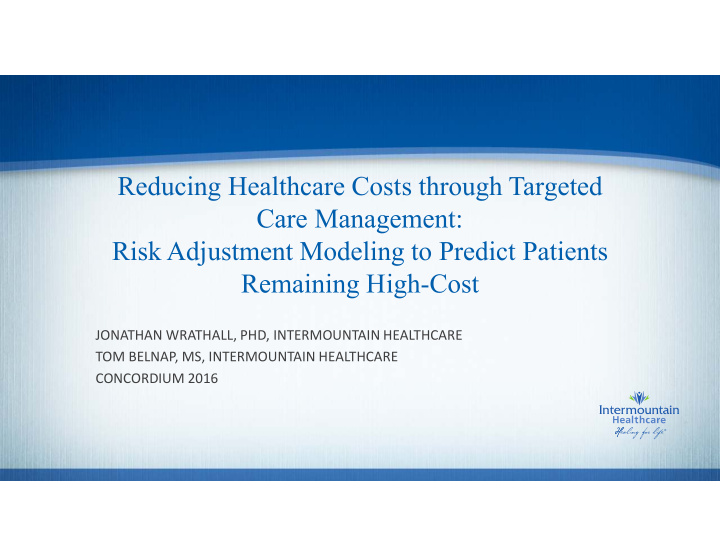



Reducing Healthcare Costs through Targeted Care Management: Risk Adjustment Modeling to Predict Patients Remaining High-Cost JONATHAN WRATHALL, PHD, INTERMOUNTAIN HEALTHCARE TOM BELNAP, MS, INTERMOUNTAIN HEALTHCARE CONCORDIUM 2016
Highest Costs Originate Among Select Few At Intermountain Healthcare: • Among patients in the highest cost decile in 2012: – 20% of patients remained in the highest cost decile in 2013. – 18% of patients remained in the highest cost decile in 2014. • From 2008-2012, top 5% high-cost patients incurred 51% of healthcare costs. • In 2012, Top 1% of patients incurred 24% of healthcare costs • Most of these patients have at least one chronic condition How can we respond to these challenges?
Community Care Management What is CCM? Model Design – Initial In-home assessment by appropriate – Longitudinal care management discipline pilot – Interdisciplinary – • Not embedded in a clinic Dedicated Clinical Pharmacist, Care Conferences with PCPs, Community Which Patients? based Resources, other Care Managers. 1. Retrospective Referrals – Referrals to internal and community-based resources – Highest cost and most complex – Intensive Care Coordination to navigate patients complexities of healthcare 2. Concurrent Referrals – Community Integration Core Team – Highest risk from other care – managers or clinicians Community Care Manager (RN) – Community Care Social Worker (MSW) 3. Additional Inclusions/Exclusions – Community Care Transitionist
Objectives • Improve upon the current pre-screening ranking algorithm to identify & prioritize patients for care managers to reach out to. – Prioritize patients sooner – Require less data • Proof of concept – This process can be refined as care management teams define strategy around what services they will provide.
CCM Pre-Screening Cost-Rank Algorithm Rank • Living Adults • Not enrolled in a care management program • Not a transplant patient • Hospital Costs* in the previous year • Select Health or uninsured • Indigo Expected Benefit Score • Within 30 miles of a Care Management Clinic • Charlson Comorbidity Index Score • In Top 10% of hospital costs* in the previous year • Optum Prospective Risk Score & in Top 15% in one of the two years prior Sample *Hospital costs exclude chemotherapy, dialysis, IV therapy, spinal fusion, knee & hip replacement
Proposed Changes to a Predictive Logistic Model Variables •Likelihood of Pre-Screening Patients Remaining In Top 15% of •Living Adults Cost For 2 of 3 Future Years •Not enrolled in a care management program •Tested multiple models aimed at limiting regression to the •Not a transplant patient mean • Hospital and MG Costs* in the previous year •Select Health or uninsured •CART, Random Forests, & Logistic Regression • Charlson Comorbidity Index Score •Within 30 miles of a Care Management Clinic • Indigo Expected Benefit Score •In Top 15% of hospital* & MG Cost in the previous year • Optum Prospective Risk Score & in Top 15% in one of two prior years + Additional Patient Demographics + Additional Health Information Predict Sample *Hospital costs exclude chemotherapy, dialysis, IV therapy, spinal fusion, knee & hip replacement
Demographic & Health Information Persistent Top 15% ~ Demographic Factors + SocioEconomic Factors + Comorbidities + ε �� !"#!$ Behavioral Health Conditions Demographic Factors Charlson Comorbidities Socio-Economic Factors Schizophrenic Disorders Myocardial Infarction Age Average Household Income Cancer Depression Gender in Patient ZIP Code Bipolar Connective Tissue Disease-Rheumatic Disease Marital Status Singh Area Deprivation Index Affective Disorders Chronic Pulmonary Disease in Patient Census Block Organic Psychotic Conditions Cerebrovascular Disease Nonorganic Psychoses Metastatic Carcinoma Neurotic Disorders Dementia • Random Forest Classification Personality Disorders Moderate or Severe Liver Disease Alcohol/Drug Dependence Diabetes with complications – variables selected based on Variable Importance Diabetes without complications Eating Disorders Childhood/Adolesence Disorders Mild Liver Disease Matrix Intellect Disability Periphral Vascular Disease • AIDS/HIV Logistic Regression performed better than Additional Comorbidities Peptic Ulcer Disease Obstructive Sleep Apnea Congestive Heart Failure Random Forest and outperformed CART. Hyperlipidemia Renal Disease Morbid Obesity Paraplegia and Hemiplegia Coronary Artery Disease Hypertension
Modeling Results Measure Cost-Rank Model Logistic Model C-statistic .536 .712 Likelihood of Pre-Screening Patients Remaining In Top 15% of Cost 63.0% 79.0% For 1 of 3 Future Years Likelihood of Pre-Screening Patients Remaining In Top 15% of Cost 31.0% 48.1% For 2 of 3 Future Years Identified Patients 1,400 1,800 Avg. Prior Year Cost $38,700 $44,000 % with Area Deprivation Index > 115 (Top Quintile) 16.9% 18.0% Avg. Number of Charlson Comorbidities 3.6 5.0 Avg. Number of Behavioral Health Conditions 1.7 2.2 Avg. Number of Other Comorbidities 1.4 2.3 Diagnosed With Behavioral Health Condition 63.2% 82.8% Diagnosed With Obesity 27.8% 54.9% Diagnosed With Hypertension Patients 59.3% 80.3%
Improving Patient Intervention Targets Prediction vs Ranking • Relatively simple variables can improve predictive power – Basic prediction model includes administrative data with additional persistent comorbidities. – Did not require lengthy cost history. – Some difficulty in obtaining socioeconomic context variables. • Populations may have specific characteristics unique to them. – Be sensitive to sample characteristics.
Questions? Thank you
Recommend
More recommend